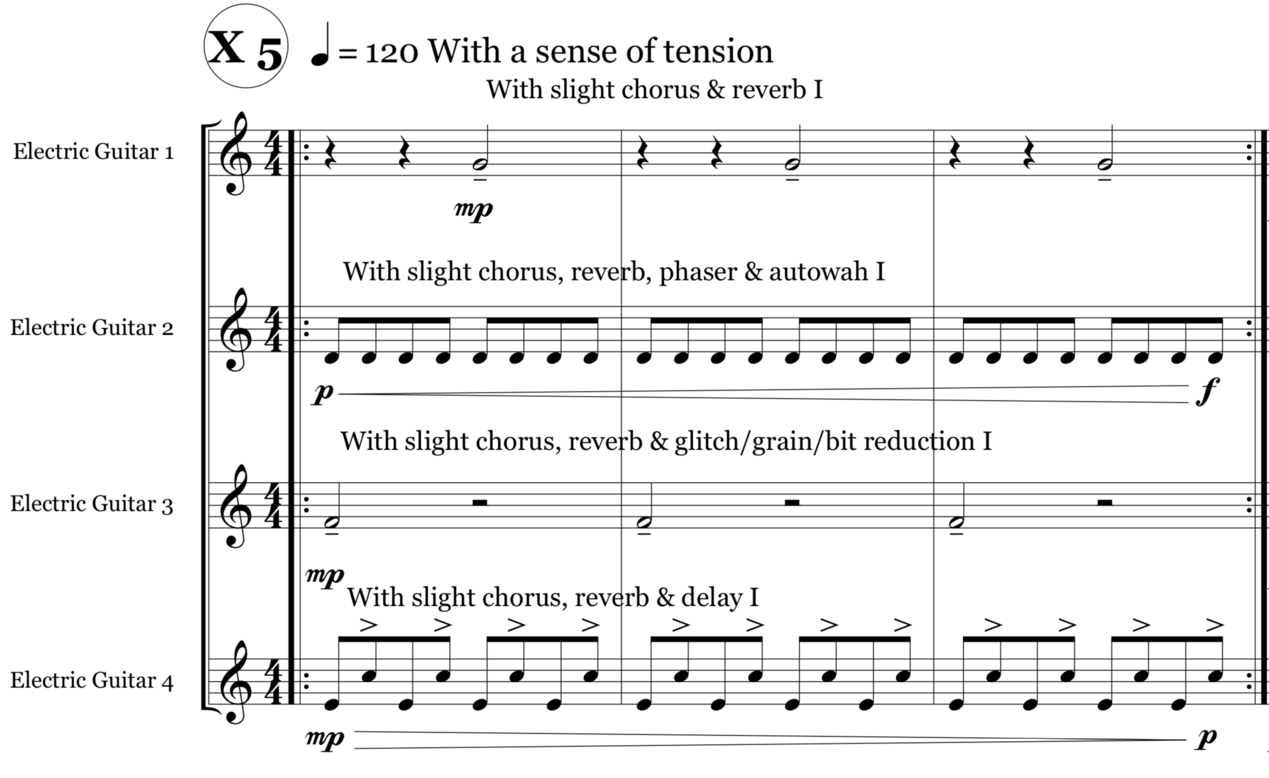LITERATURE REVIEW
Musical antecedents to this methodology of transcription leading to translation include: Olivier Messiaen's Oiseaux Exotiques (1995-56) where birdsong is transcribed and interpreted in music; George Brecht's Time Table Event (1961), which repurposes a train timetable into a score; John Cage's Cheap Imitation (1969), which repurposes the rhythmic structure of Erik Satie's Socrate (1920); Gerald Barry's Piano Quartet No. 1 (1992), which transcribes and transforms Irish folk melodies; Jonathan Burrows and Matteo Fargion's Both Sitting Duet (2002), which translates Morton Feldman's For John Cage (1982) into a piece of dance; and Michael Wolters's Antarctica Duet (2003), which sets a cross-section diagram of Antarctica to music.
Contemporaneous works include Cassandra Miller's For Mira (2012), which digitally transcribes Nirvana's version of Where Did You Sleep Last Night (1994), and Jennifer Walshe's Ireland a Dataset (2020) which trained AI to compose or translate music from Enya and The Dubliners.
GENERAL OVERVIEW
The aim of this body of work is to explore translation, the act of communicating the meaning of one phenomenon (the source) to another phenomenon (the target) through musical composition. This is illustrated by three related works that translate different events/objects into musical experiences:
1. Fourteen Minutes of Music on the Subject of Greeting Cards
2. Forty-Five Minutes of Music on the Subject of Football
3. Ireland England
The intention is to create interesting structures through innovative compositional techniques that may be taken up by others. The act of translation imbues the musical work with meaning relating to our lived experiences. As a result, composition as lived experience becomes the overarching narrative, highlighting a departure from more abstract or distanced concerns to hyper-personal ones.
WHAT OTHER PEOPLE SAY ABOUT THIS WORK
Fourteen Minutes of Music on the Subject of Greeting Cards
‘I was especially moved by the young Irish composer Sean Clancy’s Fourteen Minutes of Music on the Subject of Greeting Cards. Trite Hallmark-style phrases like “You Are 4” were projected on a screen, tracing life events from graduations to retirements to condolences. As greetings come and go, a flute, violin and piano play compact, beautifully simple yet elusive musical phrases. The piano part is similarly fixated on subtly changing themes.’
Anthony Tommasini, April 13, 2016, New York Times
‘Slight variations in the basic theme, particularly on the piano, quietly underlined the emotional arc of an average life. At first, it was bouncy and cutesy as the phrases announced the birth of a baby and subsequent young birthdays, followed by joyous occasions such as graduations, weddings, and new jobs. But, there were also sympathy messages marking the disappointments of life: careers and marriages lost, illness and, finally, death. For me, this was the most memorable piece of the entire festival.’
Steven Pisano April 26, 2016, Feast of Music
‘The pièce de résistance was Sean Clancy‘s Fourteen Minutes on the Subject of Greeting Cards. Short titles from actual greeting cards were projected behind the trio of piano, violin and flute as variations on a brief series of cells unfolded dreamily, measure by measure, each with its own distinct time signature. Suddenly the infant is three, then he’s getting his license; woops, he’s had an accident. By now, it was obvious where this was going. Or was it? Hint: as a minimalist cavatina, it had brought MATA artistic director Du Yun to tears.’
Delarue, April 13, 2016, New York Music Daily
‘Seán Clancy’s Fourteen Minutes of Music on the Subject of Greeting Cards was entirely different. Written for flute, violin, piano, with the projection of various lines from greeting cards. The music is quiet, modest, with slow, sustained tones in the flute and violin, and equally slow, miniature phrases on the piano. The projection creates a narrative of life, from birth to death, and with the music the experience was a poignant lament.’
George Grella, April 13, 2016, New York Classical Review
Forty-Five Minutes of Music on the Subject of Football
‘Another electric Guitar quartet, Sweden’s Krock, commissioned one of the most affecting Irish works of recent years. Seán Clancy’s quartet Forty-Five Minutes of Music on the Subject of Football is modelled on a signal moment in Irish cultural memory: the first half of the match between the Republic of Ireland and Italy at the 1994 World Cup in the USA. Clancy maps the game’s events (who has the ball at a given time, Ray Houghton’s goal, etc.) on to the musical material and time scheme. Performed with Pathos by Krock, the result is a fascinating exploration of culture and nostalgia, and also nods to the Dublin underground rock scene.’
Liam Cagney, February 2020, Gramophone
'In thematising this particular game of football, Clancy’s work delves into Irish cultural memory, in which the game represents something deeper-felt. A nostalgic air is palpable. More proper comparisons, then, are with Barthes’s Mythologies (and its remarks such as ‘cars today are almost the exact equivalent of the great Gothic cathedrals’) and Warhol’s screen-prints of gaudily coloured cultural icons, equal parts sacred, seductive and superficial. The ‘pop’ element further informs the instrumentation and style, which, as I have said, mirror the post-rock of bands like Explosions in the Sky. Caveats about national designations notwithstanding, Forty-Five Minutes of Music on the Subject of Football does seem a major new ‘Irish’ composition.’
Liam Cagney January 2016, Tempo
'A glance at Clancy’s score reveals a piece of music that might reflect the joy of that occasion — Ireland’s only win in that competition. A constant fast pulse runs almost continuously throughout the piece, with a series of looped patterns rising and falling in loudness, density and intricacy. The instrumental colour changes. There are moments of sudden difference, and other moments of gradual transition. The music moves from even metres with unchanging patterns, to irregular metres with intense bursts of energy. Clancy’s composition might just be a work of football through to the final whistle.'
Benedict Schlepper-Connolly, 11 July, 2014, Journal of Music
CREATIVE COMPOSITIONAL WORK 3
Ireland England
Full Performance
CLICK TO PLAY
Video excerpt: 4:10
CLICK TO PLAY
Music performed by Seán Clancy
Video created by Seán Clancy
CREATIVE COMPOSITIONAL WORK 1
Fourteen Minutes of Music on the Subject of Greeting Cards
Full Performance: 14:00
CLICK TO PLAY
Video Excerpt: 4:40
CLICK TO PLAY
Music performed by Crash Ensemble.
Video created by Seán Clancy.
CREATIVE COMPOSITIONAL WORK 2
Forty-Five Minutes of Music on the Subject of Football
Full Performance: 45:00
CLICK TO PLAY
Audio Excerpt: 6:29
CLICK TO PLAY
Music performed by Ensemble Krock.
Video created by Sean Treacy and Dave Knox.
Audio recorded and mixed by John 'Spud' Murphy.
PROCESS I – TRANSLATING STRUCTURES
The three works can be considered a continuation of my PhD research, which examined the act of artistic intervention/adaptive reuse. Put simply this was adding my own material to pre-existing (musical) structures, and perhaps reframing the original work’s meaning. Here, however, I began to think about using non-musical structures, and rather than altering the work's meaning, the research question became about investigating what would happen if I try to preserve the original meaning, or my experience of the meaning.
It is evident from my literature review that other people have used similar compositional strategies to myself. However, in my outputs the translations maintain the meaning (or experience) of the original thing that is being translated (the same thing said in a different way), rather than intervening, or critiquing. This is different to the examples outlined in my literature review that perhaps transcribe pre-existing music into another music, altering the original's meaning. I believe that the term translation is most useful in this context, because I am moving from different mediums into music, whilst trying to maintain my initial experience of the original; whereas terms like transcription or transposition all suggest activites within music without the cross from one medium into another. By foregrounding the meaning of the original phenomenon, this body of work draws attention to shared socio-cultural experiences (our relationship to greeting cards, sport lifting the spirits of a people during economic hardship, the Repeal the 8th movement), and acts as a vehicle for me to explore, understand, and share my lived experience. This last aspect has opened up a new avenue of exploration for me, particularly in the last four years, where I am increasingly incorporating concrète sounds from my day-to-day lived experience in my work.
Fourteen Minutes of Music on the Subject of Greeting Cards came about after seeing David Theobald's video piece Deepest Sympathy (2011) in the IKON gallery, Birmingham. The piece had a matter of fact profundity to it, and had a deep impact on me. I wanted to capture this impact in sound, so I went about translating it (one medium to another whilst keeping the original meaning). This involved repurposing the text of the original video (55 greeting card phrases documenting a life from the cradle to the grave) to give me my piece's durational structure. This structure was then scaled up 3.5 times to turn a 4 minute piece into a 14 minute piece (the length of the commissioned work). The narrative from the video then dictated the how the musical content would unfold. Specific milestones such as adolescence, marrige, divorce etc. were punctuated, and additional material or voices were added or removed when more characters enter or exit the protagonist's life. The end result is a piece that translates a work of video art into a piece of music, that hopefully maintains its original meaning, but also captures my lived experience of this object.
In Forty-Five Minutes of Music on the Subject of Football I mapped out the structure of Ireland v. Italy in USA 94. By structure, I am referring to the duration of each team having the ball. With each possession, I chipped away at two respective blocks of material, and events in the match determined the tempo, texture, and timbre of the material. The overall soundworld of this piece alludes to the music that I was listening to in 1994 and is perhaps reminiscent of Nirvana, and the Smashing Pumpkins. The piece translates only the first half of the match, because one my initial aims with this piece was to address ideas relating to how long individuals can pay attention to a single phenomenon for. As I see it, during a football match, our attention diverts to other things at half time (TV adverts, conversation, going to the bar etc), so the attention to a singular activity ends after forty-five minutes.
The third piece in this output, Ireland England, translates the durational structure of my weekly plane journey between Dublin and Birmingham. Here the structure relates to different parts of the journey: safety announcement, taxi, take-off, cruising, descent, landing, and taxi. Each section has its own musical material derived from the letters in Ireland and England. Each section also deals with specific subject matter relating to reasons why Irish people travel to Britain - to find work, to escape conflict, for sporting events, for holidays and leisure, for relationships and family visits - and culminates in information about the Repeal The 8th movement in Ireland (a successful campaign to end the prohibition of abortion in Ireland in 2018).
For this piece, I meticulously researched facts and figures from the Central Statistics Office Ireland, Office for National Stastics, UK, censuses in Ireland and the UK, newspaper articles from the British and Irish press, as well as anecdotal evidence from my own experiences as someone who travels between the UK and Ireland on a weekly basis. All of this information is projected on a screen during performance. The soundworld also relates to my experience of my own journey, specifically the drones one hears when on a plane.
This example comes from the sketches of Forty-Five Minutes of Music on the Subject of Football. Here I have created the first sixteen pitches of an infinite sequence by reading the interval between the first two pitches, and using that interval to generate each consecutive interval, first in its inversion (upward beams), then in its prime (downward beams). This process can go on forever without repeating exactly, and can be applied to any interval, using any kind of tuning, modality, tonality or serial system.
For me, however, I didn’t want to accept the system just as it is (as it can become a little predictable, when used often), so I use chance to determine auxiliary pitch material. This can be seen in the example below (CLICK IMAGE TO ENLARGE):
PROCESS II – INPUTTING MATERIAL TO TRANSLATED STRUCTURES
Chance
Once I have translated a durational structure from a pre-existing phenomenon, I use chance to determine a number of musical parameters. For this body of work, chance was used to determine time signatures and some pitch content. For example, in Fourteen Minutes of Music on the Subject of Greeting Cards and Forty-Five Minutes of Music on the Subject of Football, I assigned the numbers 1-7 to the following meters 3/8, 2/4, 5/8, 6/8, 3/4, 7/8, 4/4. I then generated many sequences using a random number generator, to give me something that might look like the following: 7/8 (6), 3/8 (1), 2/4 (2), 5/8 (3), 6/8 (4), 3/4 (5), 4/4 (7). For Fourteen Minutes of Music on the Subject of Greeting Cards this process was used to change the meter every measure, and in Forty-Five Minutes of Music on the Subject of Football this process was used to change the meter every 3, 4, or 8 measures. In the former I wanted a more irregular pulse, whilst in the latter I wanted something a little more regular.
Chance is also used to determine some pitch content, which I will discuss below.
Infinity Series
The majority of my pitch content is derived from my use of the infinity series, which I first encountered through the music of Per Nørgård. An example of my use can be seen below (CLICK IMAGE TO ENLARGE):
The E, F, D, G in guitars 1-4 are all derived from the infinity series outlined above; however, the auxiliary C in guitar 4 occurs as the result of chance. In this piece, the chance technique was me asking a random number generator to give me an interval between a 2nd and a 7th.
The same process is used in Fourteen Minutes of Music on the Subject of Greeting Cards, and in parts of Ireland England; although in the latter piece I also generated pitch content from a musical cryptogram on the words Ireland and England.
Taste, Reliability of Memory, and composition as Lived Experience
I use chance for a number of reasons. Firstly, I am quite an indecisive person, and compositional decisions are difficult for me. In the end I find that one decision can be just as good as any other decision, thus I am happy to allow chance to determine a number of things within the bounds of something that I am happy to establish.
Secondly, our taste can change over time. What I like one day, might change over a period of days, weeks, or months. As a result, I don't find it particularly useful to create art that is based on what one likes at the time of creation. Nevertheless, I still establish certain boundaries that can arguably be linked to a kind of global taste that I may have. So perhaps I'm not entirely giving my aesthetic over to indeterminacy.
Relatedly, our memory is not a reliable source. We can misremember things, and our account of something might be very different from someone else's. Since these works are dealing with a lived experience, or my account of a lived experience, I think it’s important to imbue them with a sense of uncertainty derived from indeterminacy.
DISSEMINATION OF THE RESEARCH
These three creative outputs have been performed globally and written about numerous times in the public realm as outlined elsewhere in this exposition. Documentation of each work exists online and in physical formats (as well as in this exposition). Scores are available in hardcopy from the Contemporary Music Centre, Dublin, and recordings or videos are available to stream for free on YouTube, and Bandcamp. Forty-Five Minutes of Music on the Subject of Football has been released by Birmingham Record Company and distributed by NMC, and is available on CD and via streaming services such as Spotify. This piece was also broadcast on New Sounds on WNYC.
These three works and the concepts behind them are used as examples in undergraduate teaching at Royal Birmingham Conservatoire, particularly in the BMus 3 Applied Composition module, which discusses these pieces, and offers an assessment question for students to engage with. Some of the ideas contained within are also discussed by colleagues in the BMus 1 Composition Studies module, and I have anecdotal evidence that these ideas are also taught by colleagues at other institutions. I have also given masterclasses and seminars about these methods at several institutions in the UK, Ireland, Canada, China, and Sweden.
Live performances
Fourteen Minutes of Music on the Subject of Greeting Cards
3 October 2013 – Performed by Sara Minelli, Aisha Orazbayeva, and Matthew Schellhorn, Little Missenden Church, Little Missenden.
17 April 2014 – Performed by Crash Ensemble, Project Arts Centre, Dublin.
6 October 2014 – Performed by Octandre Ensemble, Little Missenden Church, Little Missenden Festival.
7 March 2015 – Performed by Crash Ensemble, National Concert Hall, Dublin.
12 April 2016 – Performed by Ensemble Neon, Mata Festival, Scandinavia House, New York.
Forty-Five Minutes of Music on the Subject of Football
3 June 2014 – Performed by Ensemble Krock, Recital Hall, Birmingham Conservatoire, Birmingham.
11 July 2014 – Performed by Ensemble Krock, National Concert Hall, Dublin.
7 December, 2014 – Performed by Ensemble Krock, Fylkingen, Stockholm.
1 November 2016 – Performed by Ensemble Krock, Värmdö Culture School, Gustavsberg.
Ireland England
10 May 2018 – Performed by Seán Clancy, the Rose Hill, Brighton.
18 May 2018 – Performed by Seán Clancy, Centrala, Birmingham.
16 October 2018 – Performed by Seán Clancy, City University, London.
17 October 2018 – Performed by Seán Clancy, R10, Leicester.
6 December 2018 – Performed by Seán Clancy, The Arches, Southampton.
Public funding and support
Fourteen Minutes of Music on the Subject of Greeting Cards was supported by Britten Pears Foundation (now Britten Pears Arts) and the RVW Trust; Forty-Five Minutes of Music on the Subject of Football was supported by Statens musikverk; and Ireland England was supported by Culture Ireland.








